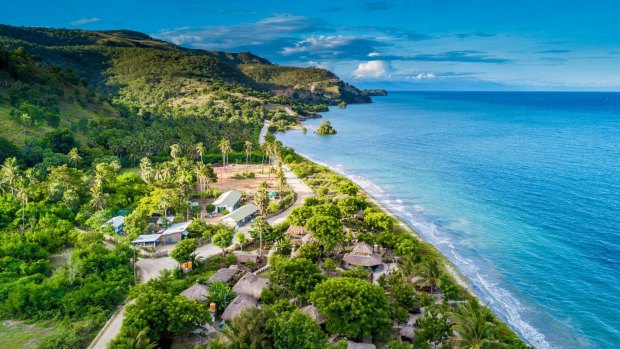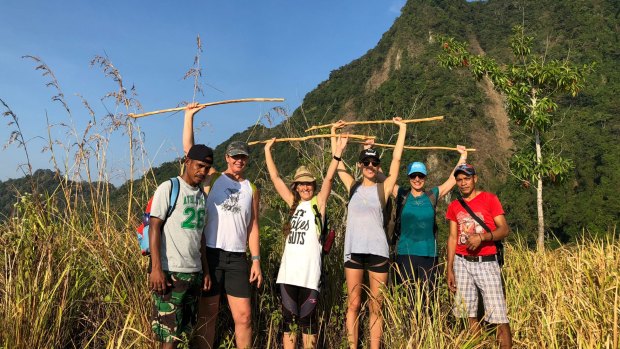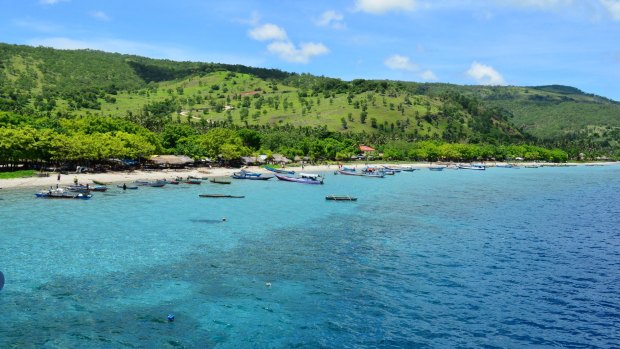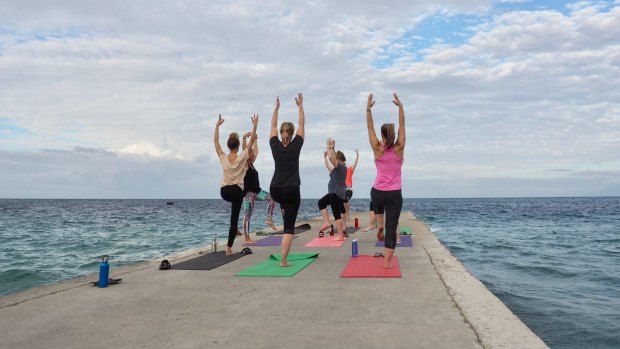This was published 5 years ago
Timor-Leste travel guide: A perfect destination for a digital detox
By Nina Karnikowski

A place to truly get away from it all: Atauro island.
The highlight of my week in Timor-Leste was reading an entire book. Which may seem odd, when you consider that this underrated destination offers empty beaches, some of the world's best diving, vibrant markets and more. But also consider how increasingly rare it is for time-poor, technology-addled humans like myself to spend almost a whole day reading. Luxurious doesn't even begin to cut it.
The crucial element for indulging in this kind of simple luxury was being off-grid, which I was from the moment our all-female septet arrived on Atauro island for an active holiday with Sharing Bali & Beyond. That this island was a sanctuary from technology seemed fitting. Historically, it had provided safe haven of a different kind. During Timor-Leste's violent 1999 and 2006 crises, Atauro's community was protected from destruction thanks to their isolated location 36 kilometres off the coast of Dili.
This week, it was emails, texts and social media that this writer and avid Instagrammer (who once counted how many times she checked that app in a day and found it was over 40) needed protection from. I was shown to my bamboo hut at our simple eco-lodge with its grass roof, latticed windows and location just metres from the beach, and instantly felt this space would help me find the clarity and sanity I'd been craving.

The itinerary was filled with yoga and fitness training, including daily hikes.
That first twilight we gathered on the beachfront and were briefed on what to expect from our time on the island by Sharing Bali & Beyond's founder, a petite, fit, effervescent woman in her mid-50s named Karen Willis. Our itinerary was filled with yoga and fitness training, daily hikes, village visits and snorkelling, but plenty of spare time, too. Without a phone in my pocket, however, I wondered what I'd do with it all. As someone used to filling her days until they burst, slipping into the slow lane was a little painful at first.
Take our first free afternoon, for example. I decided I'd just hang in the hammock on my balcony, writing in the journal we'd been given at the beginning of the trip. I did that, for five minutes. But then I remembered I should take some photos, so I did that. Then I lay in the hammock. A few minutes later, I remembered I hadn't rinsed my swimsuit after my morning swim, so I did that. Then I lay back in the hammock. A few minutes later … You get the picture. It was exhausting. I was happy when the free time was up.
"We tell ourselves that so many things are urgent in our lives, but really, slowing down is what's most urgent," said one of my co-travellers at dinner that night, eaten at a wooden table under the stars with our feet in the sand.

Atauro island, a sanctuary from technology.Credit: Alamy
It's true, of course, and the reason behind the current rise in "digital detox" holidays, where travellers can luxuriate in tech-free days and counter our device addictions. But it isn't as easy as simply putting the phone away. There are withdrawals. A mental twitchiness that takes time to dissipate.
The next morning we hiked to a clifftop to watch the sunrise over the ocean. It should have been a serene moment, waiting for the golden orb to crack over the horizon and spill glitter over the sea. And yet I spent most of the time photographing it, my charged brain fizzing with Instagram ideas even though I knew posting was an impossibility. Like a smoker trying to kick the habit, without the ability to use my phone I found my thoughts obsessively returning to it.
As difficult as disconnection was, a destination as relaxed as Timor-Leste gives travellers as good a chance as any of achieving it.

Oceanfront yoga.
Following a painful past, including the Indonesian invasion during which as many as 183,000 East Timorese died, Timor-Leste is finally forging its own path to a more prosperous future, but it's a slow process. Which means it's still quiet and laid-back. A place where local women sit barefoot in the dirt weaving baskets out of palm fronds. Where fishermen sit beneath trees watching their morning catch, strung from the branches above, dry in the breeze. Where visitors are reminded that time is indeed one of the great luxuries.
By day three, thanks to a combination of flogging my body with three-hour hikes, high intensity fitness sessions on the beach, a massage and all that forced relaxation time, the arteries of my mind felt like they had unclogged a little. There was a bit of empty space in there. I found an excellent Ann Patchett book on the communal bookshelf and was able to lie down and read it for hours at a time, finishing the thing in two days. That hadn't happened in about a decade.
As the virtual veil lifted, I could see the world properly for what felt like the first time in a while. I could sit and watch the ocean without itching to share it with an online community of people I'd never met, a habit that started to seem strange when observed from afar. I could enjoy long, rambling conversations without worrying about where they were leading or when they would end.
On our last island afternoon, Sharing Bali & Beyond's fitness and wellness trainer asked us to pluck a seashell from the sand and just look at it for three minutes. I turned that small white shell, with its corrugated surface and mauve-tinged interior, over in my hands. I remembered how as a kid I would sit in our small suburban garden for hours, microscope in hand, inspecting the petals of white paper daisies, the bodies of the skinks I'd find, the ants I'd capture inside my ant farm.
When had I forgotten how to do this? How to take a few minutes from my day to properly look at the things around me? I was grateful for the reminder.
TRIP NOTES
Nina Karnikowski travelled as a guest of Sharing Bali & Beyond.
MORE
FLY
Air North flies from Darwin to Dili, an 80-minute flight, for about $488 return. See airnorth.com.au
TOUR
Sharing Bali & Beyond's five-night Timor-Leste adventure, including three nights in an eco-lodge and two nights in Dili, is from $1750 a person, twin share, including boat transfers, snorkelling and guided hiking, three fitness sessions and more. Flights not included. See sharingbaliandbeyond.com
FIVE OTHER THINGS TO DO IN TIMOR-LESTE
TAIS HANDICRAFT MARKET
Tais, the traditional colourful Timorese woven textile, make beautiful tablecloths. You can find them at the Tais Market, where prices are reflective of quality and the hard-sell doesn't exist.
BONECA DE ATAURO
This Atauro island women's co-operative supports 60 families and produces gorgeous handmade dolls, as well as embroidered pillowcases, bags, decorations and more. Open 8.30am to 5pm, Mon-Sat.
SANTA CRUZ CEMETERY
The site of the tragic murder of more than 250 civilians taking part in a peaceful procession in 1991, this cemetery is worth a visit for both the reminder of how far this country has come, and also to see the beautiful, pastel-hued gravestones filling it.
DILI ROCK
Set on the western outskirts of Dili, this easily accessible dive spot is also said to be a hotspot for manta rays.
RESISTANCE MUSEUM
Chronicling Timor's independence struggle, this museum consists mainly of text running the length of a wall and some artefacts, but is an important memorial to a dark time in the country's history.
Sign up for the Traveller Deals newsletter
Get exclusive travel deals delivered straight to your inbox. Sign up now.